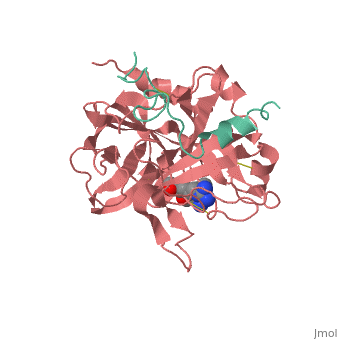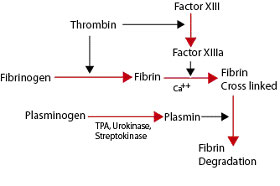Sandbox Reserved 483
From Proteopedia
| This Sandbox is Reserved from 13/03/2012, through 01/06/2012 for use in the course "Proteins and Molecular Mechanisms" taught by Robert B. Rose at the North Carolina State University, Raleigh, NC USA. This reservation includes Sandbox Reserved 451 through Sandbox Reserved 500. | ||||||
To get started:
More help: Help:Editing For more help, look at this link: http://www.proteopedia.org/wiki/index.php/Help:Getting_Started_in_Proteopedia Thrombin (Factor IIa)Introduction
Thrombin is a Trypsin like Serine protease (1). It uses the serine amino acid to specifically cleave fibrinogen into fibrin (3).This forms a blood clot which stops blood from leaking out of the blood circulatory system in case of a rupture. It also catalyzes the activation of factor XIII which stabilizes the fibrin network (3). It additionally aids in inflammatory responses by activating neutrophils and platelet (2). For individuals at risk for heart attacks, many times they will take a daily aspirin regimen as recommended by their doctors. This effectively thins out the blood and makes blood clotting less effective, therefore putting less strain on the heart. Inversely, for those individuals with a non-functioning thrombin could result in hemophilia, a genetic condition in which excessive bleeding occurs due to the bodies inability to properly contain blood vessel ruptures(3). Structure The thrombin molecular structure can be divided into two chains along the . The first chain (chain A) has 36 residues and is non-essential for proteolytic activities. The second chain (chain B) has a total of 259 amino acid residues and is derived from the carboxyl terminal sequence of prothrombin (2). With the B chain containing 3 amino acids, His57, Asp102, and Ser195 (2).
Mechanism of action Thrombin selectively cleaves fibrinogen into loose fibrin. Fibrin then forms a mesh network which traps anything within it. This mesh network is stabilized by factor XIII, which is also activated by thrombin. This can be signaled to occur via an extrinsic or an intrinsic pathway (3). That is to say that if the rupture occurs within the organism it will go through an intrinsic signaling pathway, and if the rupture exposes blood to the environment outside of the organism, then it will go through an extrinsic pathway. The fibrin then forms a mesh of interlocking strands which is catalyzed by plasma protein factor XIII, who’s activation is also catalyzed by thrombin (3).
If thrombin does not work correctly then it may not correctly activate factor VIII into factor VIIIa, this is directly related to the activation of platelets, as such, if this is not active, then the individual will be unable to form clots. This results in the condition known as hemophilia (3). Additionally,in surgical procedures where it is necessary to stop the flow of blood, or even within boxing matches where cuts on the face required a means to put a stop to bleeding, thrombin is used as a hemostatic aid to slow, or stop bleeding(3). References Source 1: http://www.rcsb.org/pdb/101/motm.do?momID=25 Source 2: http://serpins.med.unc.edu/~fcc/ResearchPicts2006/Thrombin.html Source 3: Widmaier, Eric P., Hershel Raff, Kevin T. Strang, and Arthur J. Vander. "Cardiovascular Physiology." Vander's Human Physiology: The Mechanisms of Body Function. Boston: McGraw-Hill Higher Education, 2008. 423-27. Print. Source 5: http://www.pdb.org/pdb/101/motm_disscussed_entry.do?id=1ppb |


